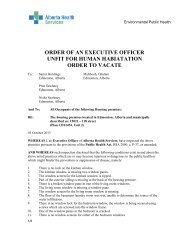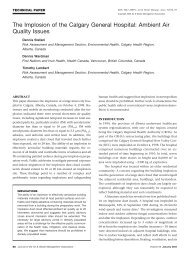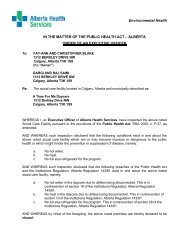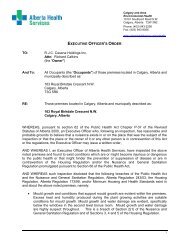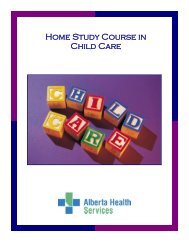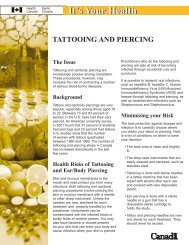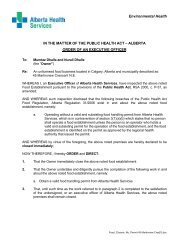Vulnerable Populations in Alberta Report - Alberta Health Services
Vulnerable Populations in Alberta Report - Alberta Health Services
Vulnerable Populations in Alberta Report - Alberta Health Services
Create successful ePaper yourself
Turn your PDF publications into a flip-book with our unique Google optimized e-Paper software.
<strong>Vulnerable</strong> <strong>Populations</strong><br />
In <strong>Alberta</strong><br />
June 2011<br />
Prepared by:<br />
Reduc<strong>in</strong>g Disparities<br />
<strong>Health</strong> Promotion Disease and Injury Prevention<br />
Population & Public <strong>Health</strong><br />
<strong>Alberta</strong> <strong>Health</strong> <strong>Services</strong><br />
1
Introduction<br />
<strong>Vulnerable</strong> <strong>Populations</strong> <strong>in</strong> <strong>Alberta</strong><br />
On the whole <strong>Alberta</strong>ns enjoy good to excellent physical and mental health. A closer look at health<br />
outcomes, however, reveals that some groups are healthier than others. Differences <strong>in</strong> health are<br />
not randomly distributed. Groups that experience poor health - Aborig<strong>in</strong>al People, residents of<br />
northern and remote communities, and those with low <strong>in</strong>come and education – are made vulnerable<br />
largely due to their life circumstances.<br />
The existence of health <strong>in</strong>equalities is a concern for all <strong>Alberta</strong>ns. Beyond the ethical imperative for<br />
health equity, <strong>in</strong>equalities put pressures on health and welfare systems and <strong>in</strong>crease the costs to<br />
taxpayers as a whole. For example, <strong>in</strong> Canada as a whole, the poorest 20% of the population use<br />
31% of the all healthcare services. It is estimated that 20% of health care spend<strong>in</strong>g may be<br />
attributable to <strong>in</strong>come <strong>in</strong>equalities. (Public <strong>Health</strong> Agency of Canada, 1994)<br />
<strong>Alberta</strong> <strong>Health</strong> <strong>Services</strong> (AHS) is committed to reduc<strong>in</strong>g <strong>in</strong>equalities <strong>in</strong> the health of <strong>Alberta</strong>ns<br />
through a number of key priorities <strong>in</strong>clud<strong>in</strong>g reorient<strong>in</strong>g exist<strong>in</strong>g services and develop<strong>in</strong>g targeted<br />
services. “While it is important to th<strong>in</strong>k of <strong>Alberta</strong> as a whole it is also important to give special<br />
attention to diverse population needs with the aim to reduce <strong>in</strong>equalities of outcomes”. (<strong>Alberta</strong><br />
<strong>Health</strong> <strong>Services</strong>, 2009)<br />
This document will suggest a def<strong>in</strong>ition of vulnerable populations, identify those populations <strong>in</strong><br />
<strong>Alberta</strong> that are vulnerable, and review what we know about what makes them vulnerable.<br />
Def<strong>in</strong>ition of <strong>Vulnerable</strong> <strong>Populations</strong><br />
<strong>Health</strong> <strong>in</strong>equalities is a generic term used to designate differences or variations <strong>in</strong> health outcomes<br />
between population groups. Some health <strong>in</strong>equalities reflect random variations (i.e., unexpla<strong>in</strong>ed<br />
causes), while others result from <strong>in</strong>dividual biological endowment, the consequences of personal<br />
choice, social organization, economic opportunity or access to health care (<strong>Alberta</strong> <strong>Health</strong> <strong>Services</strong>,<br />
Towards an Understand<strong>in</strong>g of <strong>Health</strong> Equity Glossary, 2011). (The terms disparities and <strong>in</strong>equalities<br />
are often used <strong>in</strong>terchangeably, AHS recommends the use of the term “<strong>in</strong>equalities.)<br />
[<strong>Health</strong>] Inequities are commonly referred to differences <strong>in</strong> health outcomes between population<br />
groups that are socially produced unfair and unjust (<strong>Alberta</strong> <strong>Health</strong> <strong>Services</strong>). Because identify<strong>in</strong>g<br />
health <strong>in</strong>equities <strong>in</strong>volves normative judgment, science alone cannot determ<strong>in</strong>e which <strong>in</strong>equalities are<br />
also <strong>in</strong>equitable, or what proportion of an observed <strong>in</strong>equality is unjust or unfair. Examples of health<br />
<strong>in</strong>equalities that are not considered <strong>in</strong>equitable are: voluntarily assumed risks (such as skydiv<strong>in</strong>g),<br />
pure chance (hav<strong>in</strong>g a genetic disposition to a disease), or life stage differences (better health at age<br />
20 than at age 70).<br />
The word vulnerable derives from the Lat<strong>in</strong> verb, vulnerare, mean<strong>in</strong>g “to wound” and the noun vulnus<br />
(wound). (Aday, 1994)<br />
We can make a dist<strong>in</strong>ction between “vulnerability”, the universal human condition of be<strong>in</strong>g <strong>in</strong>tact but<br />
fragile, and “susceptibility”, the condition of be<strong>in</strong>g biologically weak or diseased, with an <strong>in</strong>creased<br />
predisposition to additional harm. (Kottow, M., 2002) The dist<strong>in</strong>ction is important because it<br />
dist<strong>in</strong>guishes between the moral and professional obligation to treat the sick and the ethical<br />
obligation to ensure all populations have equal access to the resources that lead to health.<br />
We are all vulnerable to poor health, but some of us are more vulnerable than others by virtue of<br />
where and with whom we live. (Aday, 2001; Blacksher and Stone, 2002) “Although the number of<br />
Reduc<strong>in</strong>g Disparities 2
<strong>Vulnerable</strong> <strong>Populations</strong> <strong>in</strong> <strong>Alberta</strong><br />
Canadians who die prematurely and suffer from poor health is low <strong>in</strong> comparison to other countries,<br />
those who do so tend to belong to specific sub-populations – Aborig<strong>in</strong>al People, residents of northern<br />
and remote communities, and those with low <strong>in</strong>come and education.” (Butler-Jones, 2008)<br />
What makes some sub-populations more vulnerable than others is a matter of considerable debate.<br />
At the most general level, vulnerable populations are those which have less access to the resources<br />
needed to handle the <strong>in</strong>evitable risks to health that all people experience. “An <strong>in</strong>dividual’s risk is<br />
known to vary as a function of opportunities and resources associated with the follow<strong>in</strong>g social<br />
arrangements: personal traits and social status (age, sex, race, and ethnicity), ties between people<br />
(family structure, marital status, and social networks), environmental factors (school, jobs, <strong>in</strong>come,<br />
and hous<strong>in</strong>g), and associated factors (violence and/or crime).” (Leight, 2003)<br />
<strong>Vulnerable</strong> populations, then, are those which have <strong>in</strong>creased susceptibility to adverse health<br />
outcomes as a result of <strong>in</strong>equitable access to the resources needed to handle risks to health.<br />
Who is <strong>Vulnerable</strong> <strong>in</strong> <strong>Alberta</strong>?<br />
To identify vulnerable populations <strong>in</strong> <strong>Alberta</strong> we need to exam<strong>in</strong>e chronic disease rates and<br />
pattern<strong>in</strong>g. The follow<strong>in</strong>g health outcomes are commonly cited <strong>in</strong> public health literature:<br />
� Incidence of chronic diseases<br />
o Cancer<br />
o Circulatory disease (heart and stroke)<br />
o Mental health<br />
o Obesity and diabetes<br />
o COPD<br />
o HIV/AIDS<br />
� Incidence of <strong>in</strong>jury and death due to violence and suicide<br />
� Disability free life expectancy<br />
� Infant mortality<br />
� Self-reported health<br />
� System utilization<br />
o Access to and use of family physicians<br />
o Access to and use of emergency services<br />
o Access to and use of mental health services<br />
To date AHS has not systematically analyzed health outcomes to determ<strong>in</strong>e if there are any<br />
correlations with age, place, gender, <strong>in</strong>come levels, family status, education, ethnic identity, sexual<br />
orientation, etc. But based on population-specific reports that have been done and given what we<br />
know from national and <strong>in</strong>ternational trends we can draw up a provisional list of vulnerable<br />
populations <strong>in</strong> <strong>Alberta</strong>:<br />
� Aborig<strong>in</strong>al peoples;<br />
� People liv<strong>in</strong>g <strong>in</strong> poverty;<br />
� Immigrants and temporary workers;<br />
� Refugees;<br />
� People with disabilities;<br />
� People who are gender and sexually diverse;<br />
Reduc<strong>in</strong>g Disparities 3
<strong>Vulnerable</strong> <strong>Populations</strong> <strong>in</strong> <strong>Alberta</strong><br />
� People experienc<strong>in</strong>g homelessness or lack of affordable hous<strong>in</strong>g;<br />
� People with low literacy skills; and<br />
� People liv<strong>in</strong>g <strong>in</strong> poor, rural or emote communities.<br />
Further, rigorous analysis of exist<strong>in</strong>g data on health outcomes needs to be done before we can<br />
identify a def<strong>in</strong>itive list of vulnerable populations.<br />
What We Know About These <strong>Populations</strong><br />
Aborig<strong>in</strong>al Peoples<br />
Def<strong>in</strong>ition: Aborig<strong>in</strong>al peoples refers to three major groups of people <strong>in</strong> Canada; First Nations,<br />
Inuit and Métis.<br />
Numbers: In 2006 5.8% of <strong>Alberta</strong>’s population self reported as Aborig<strong>in</strong>al; 51.6% of the<br />
Aborig<strong>in</strong>al population reported as First Nations, 45.4% Metis, 0.8% Inuit, and<br />
another 2.1% who did not identify as First Nations, Metis or Inuit (Statistics Canada,<br />
2006)<br />
<strong>Health</strong>: The literature is very clear that one of the most vulnerable populations <strong>in</strong> Canada is<br />
Aborig<strong>in</strong>al People. Compared to the general Canadian populations, Aborig<strong>in</strong>al<br />
people experience a 1.5 times higher rate of heart disease and a 8-10 times higher<br />
rate of tuberculosis <strong>in</strong>fection. Type 2 diabetes is 3 to 5 times higher among<br />
Canadian First Nations and the rates are <strong>in</strong>creas<strong>in</strong>g among the Inuit. (<strong>Health</strong><br />
Canada) In 2000, life expectancy at birth for the Registered Indian population was<br />
estimated at 68.9 years for males and 76.6 years for females. This reflects<br />
differences of 8.1 years and 5.5 years, respectively, from the 2001 Canadian<br />
population's life expectancies. In 2000, suicide accounted for approximately<br />
1,079.91 potential years of life lost (PYLL) per 100,000 population <strong>in</strong> First Nations.<br />
This is nearly three times the 2001 Canadian rate. (Statistics Canada, 2009)<br />
Reduc<strong>in</strong>g Disparities 4
People liv<strong>in</strong>g <strong>in</strong> poverty<br />
<strong>Vulnerable</strong> <strong>Populations</strong> <strong>in</strong> <strong>Alberta</strong><br />
Def<strong>in</strong>ition: Poverty is a condition of not hav<strong>in</strong>g sufficient economic and other resources to live<br />
with the dignity, choices and power which support full participation <strong>in</strong> society.<br />
(Vibrant Communities Calgary, 2009)<br />
Numbers: Based on the Low Income Cut Off (LICO) rate, Statistics Canada reports 9.1% of<br />
<strong>Alberta</strong>ns are liv<strong>in</strong>g <strong>in</strong> poverty or low <strong>in</strong>come households. (Statistics Canada, 2010)<br />
They experience significantly lower health-adjusted life expectancies, a 3.5 times<br />
greater rate of disability, a 60% greater rate of two or more chronic diseases, more<br />
than three times the rate of bronchitis, and nearly double the rate of arthritis and<br />
rheumatism.(Statistics Canada, 2010; Lightman, Mitchell, Wilson, 2008)<br />
<strong>Health</strong>: In Canada as a whole the poorest fifth of the population, when compared to the<br />
richest fifth, have<br />
� More than double the rate of diabetes and heart disease<br />
� A sixty percent greater rate of two or more chronic diseases<br />
� More than three times the rate of bronchitis<br />
� Nearly double the rate of arthritis and rheumatism<br />
� A 358% greater rate of disability (Lightman, Mitchell, Wilson, 2008)<br />
� Significantly lower health-adjusted life expectancy (MacIntosh, F<strong>in</strong>es, Wilk<strong>in</strong>s,<br />
Wolfson, 2009)<br />
Immigrants and temporary foreign workers<br />
Def<strong>in</strong>ition: Immigrants are people who were born outside of Canada and have been granted the<br />
right to permanently live <strong>in</strong> Canada. Temporary workers are people who have a<br />
permit to work <strong>in</strong> Canada for a specific employer for a specific time. (<strong>Alberta</strong> <strong>Health</strong><br />
<strong>Services</strong> 2011)<br />
Numbers: Accord<strong>in</strong>g to the 2006 census, 20% of <strong>Alberta</strong>ns are first generation immigrants and<br />
19.7% are second generation immigrants. Over 80% of immigrants live <strong>in</strong> urban<br />
centres. While 17.9% of <strong>Alberta</strong>ns have a first language other than English or<br />
French. 13.9% of <strong>Alberta</strong>ns classified themselves as visible m<strong>in</strong>orities. In<br />
December 2008, there were 57,843 temporary foreign workers <strong>in</strong> <strong>Alberta</strong>, a 55%<br />
<strong>in</strong>crease <strong>in</strong> one year.<br />
<strong>Health</strong>: In general, research shows that immigrants have a lower prevalence of chronic<br />
illness, depression, and alcohol dependency compared to the Canadian-born<br />
population. (Ali, McDermott, Gravel, 2004; Perez 2002) However, certa<strong>in</strong> chronic<br />
diseases such as diabetes, cancer, hypertension and heart disease have been<br />
reported at a higher prevalence among the immigrant population compared to the<br />
Canadian-born population. (Perez 2002) Immigrants often under utilize services<br />
(such as mental health services), especially when they do not feel that the health<br />
care system fulfills their needs. (Chen, Kazanjian, 2005; Lai, 2004)<br />
Refugees<br />
Def<strong>in</strong>ition: Refugees are people who are forced to leave their country of orig<strong>in</strong> and are unable<br />
to return due to environmental factors or a well-founded fear of persecution. There<br />
are three categories of refugees <strong>in</strong> Canada: government sponsored, private<br />
sponsored and refugee claimants.<br />
Reduc<strong>in</strong>g Disparities 5
<strong>Vulnerable</strong> <strong>Populations</strong> <strong>in</strong> <strong>Alberta</strong><br />
Numbers: Accord<strong>in</strong>g to Citizenship and Immigration Canada, 3027 refugees (<strong>in</strong>clud<strong>in</strong>g both<br />
government sponsored and refugee claimants) arrived <strong>in</strong> <strong>Alberta</strong> <strong>in</strong> 2008.<br />
(Citizenship and Immigration Canada, 2008)<br />
<strong>Health</strong>: Refugees are at high risk of arriv<strong>in</strong>g to Canada with a number of physical and<br />
mental health conditions.(Dillman, Renato, Wilson, 1993; Redwood-Campbell et al.,<br />
2003; Tribe, 2002) <strong>Health</strong> problems common among refugees to Canada <strong>in</strong>clude<br />
vision and hear<strong>in</strong>g impairment, oral health problems, ear <strong>in</strong>fections, women’s sexual<br />
health problems, respiratory <strong>in</strong>fections, and mental health problems. (Dillman, 1993;<br />
Tribe, 2002)<br />
People with disabilities<br />
Def<strong>in</strong>ition: People who have a long-term or recurr<strong>in</strong>g physical, developmental, sensory,<br />
psychiatric or learn<strong>in</strong>g impairment and who consider themselves to be<br />
disadvantaged by reason of that impairment. (Human Resources and Skills<br />
Development Canada)<br />
Numbers: The proportion of people with disabilities <strong>in</strong> <strong>Alberta</strong> rose from 12% <strong>in</strong> 2001 to 14% <strong>in</strong><br />
2006. (Statistics Canada, 2001, 2006) These rates are marg<strong>in</strong>ally higher <strong>in</strong> urban<br />
centres. In September 2004, approximately 31,500 of <strong>Alberta</strong>ns were receiv<strong>in</strong>g<br />
Assured Income for the Severely Handicapped (AISH) payments. (Kneebone, 2005)<br />
45% of AISH recipients had a physical disability, while 23% had a developmental<br />
disability, and 32% had a chronic mental illness. (Government of <strong>Alberta</strong>, 2004)<br />
<strong>Health</strong>: In general, <strong>in</strong>dividuals with a disability tend to have reduced life expectancy, a higher<br />
prevalence of serious health conditions, and <strong>in</strong>creased morbidity and mortality<br />
compared the general population. (Kerr, 2004; Bittles et al., 2002) Mental health<br />
problems are common among <strong>in</strong>dividuals with any type of disability. (Ailey, 2003)<br />
People who are gender and sexually diverse<br />
Def<strong>in</strong>ition: This population <strong>in</strong>cludes, but is not limited to people who consider themselves to be<br />
lesbian, gay, bisexual, queer, <strong>in</strong>ter-sexed, transgender, and two-spirited. (McK<strong>in</strong>ley<br />
<strong>Health</strong> Center, 2008)<br />
Numbers: Accord<strong>in</strong>g to the 2001 census, 1.2% of the <strong>Alberta</strong>ns considered themselves to be<br />
homosexual or bisexual. (Statistics Canada, 2004a) Organizations serv<strong>in</strong>g the<br />
lesbian, gay, bisexual, and transgender (LGBT) population estimate that 5-8% are<br />
LGBT.<br />
<strong>Health</strong>: A review of research <strong>in</strong> <strong>Alberta</strong> and North America as a whole reveals that gay men<br />
and transgender <strong>in</strong>dividuals have higher rates of depression and suicidal ideation,<br />
and lesbian women have lower rates of preventative screen<strong>in</strong>g. (Calgary <strong>Health</strong><br />
Region, 2007). Studies have also shown that experiences of bias, <strong>in</strong>sensitivity,<br />
discrim<strong>in</strong>ation and <strong>in</strong>appropriate or <strong>in</strong>adequate health-related services can result <strong>in</strong> a<br />
distrust of the health care system and potentially lead to avoidance of regular and<br />
preventive health care. (Ontario Public <strong>Health</strong> Association, 2000; Jackson, 2006;<br />
Davis, 2000)<br />
People experienc<strong>in</strong>g homelessness<br />
Def<strong>in</strong>ition: People experienc<strong>in</strong>g homelessness are people who do not have a permanent<br />
residence to which they can return whenever they choose. (Calgary Committee to<br />
End Homelessness, 2008) There are essentially three categories of homelessness;<br />
Reduc<strong>in</strong>g Disparities 6
<strong>Vulnerable</strong> <strong>Populations</strong> <strong>in</strong> <strong>Alberta</strong><br />
1) absolutely homeless –<strong>in</strong>dividuals who live outdoors, <strong>in</strong> areas not anticipated for<br />
human occupancy and those liv<strong>in</strong>g <strong>in</strong> community shelters, 2) “couch surf<strong>in</strong>g”<br />
homeless – <strong>in</strong>dividuals temporary stay<strong>in</strong>g with family and friends, and 3) at risk of<br />
homelessness – <strong>in</strong>dividuals liv<strong>in</strong>g <strong>in</strong> <strong>in</strong>appropriate or unsafe hous<strong>in</strong>g as well as<br />
those <strong>in</strong>dividuals who spend more than 50% of their total <strong>in</strong>come on hous<strong>in</strong>g.<br />
(Frankish, Hwang, Quantz, 2005)<br />
Numbers: In 2006 it was estimated that 8,400 <strong>Alberta</strong>ns were homeless, 14% of whom were<br />
liv<strong>in</strong>g on the street; 40% had some form of mental health problem and 50% had<br />
some history of substance abuse. (<strong>Alberta</strong> Secretariat for Action on Homelessness,<br />
2008)<br />
<strong>Health</strong>: A strong and complex relationship has been reported between homelessness and<br />
adverse health status. (Hwang, 2001; Frankish, Hwang, Quantz, 2005; Gaetz, 2004)<br />
Substance abuse, poverty, mental illness, and unemployment have all been<br />
associated with negative health implications and have been reported to be highly<br />
prevalent among the homeless. (Hwang, 2001) Mortality rates are significantly<br />
higher among the homeless compared to the overall general population. (Roy et al.,<br />
2004; Hwang, 2000) The prevalence of mental illness and substance abuse is<br />
significantly higher. (Hwang, Bugeja, 2000)<br />
People experienc<strong>in</strong>g homelessness are at greater risk of contract<strong>in</strong>g <strong>in</strong>fections and<br />
<strong>in</strong>festations such as scabies and lice, tuberculosis and other respiratory illness.<br />
Homeless <strong>in</strong>dividuals are also more likely to eat a poor diet (Tarasuk, Dachner, Li,<br />
2005; Treasury Board of Canada Secretariat), and participate <strong>in</strong> high risk behaviours<br />
such as drug use, multiple sex partners, and <strong>in</strong>consistent condom use, which puts<br />
them at risk for HIV, AIDS, hepatitis and sexually transmitted diseases. (Hwang,<br />
2001) Lack of follow-up and medication compliance is evident among the homeless.<br />
(Hwang, Gottlieb, 1999) In addition, poor chronic disease management is common.<br />
(Lee et al., 2005; Frankish, Hwang, Quantz, 2005; Hwang, Bugeja, 2000) Homeless<br />
<strong>in</strong>dividuals have high <strong>in</strong>cidence of <strong>in</strong>jury and chronic illness. (Gaetz, 2004)<br />
People with low literacy skills<br />
Def<strong>in</strong>ition: Literacy is “a complex set of abilities needed to understand and use the dom<strong>in</strong>ant<br />
symbol systems of a culture – alphabets, numbers, visual icons - for personal and<br />
community development.” (The Centre for Literacy) People with low literacy skills<br />
have difficulty access<strong>in</strong>g, understand<strong>in</strong>g, evaluat<strong>in</strong>g and communicat<strong>in</strong>g <strong>in</strong>formation<br />
<strong>in</strong> a way that will promote, ma<strong>in</strong>ta<strong>in</strong> and improve health. (Rootman, El-Bihbety,<br />
2008)<br />
Numbers: 53% of adult <strong>Alberta</strong>ns lack the literacy skills and abilities needed to obta<strong>in</strong>,<br />
understand, and act upon health <strong>in</strong>formation and to make appropriate health<br />
decision on their own. (Canadian Council on Learn<strong>in</strong>g)<br />
<strong>Health</strong>: In general, Canadians with low literacy have poorer overall health – lower life<br />
expectancy and higher rates of chronic diseases, accidents and utilization of health<br />
services. (Canadian Council on Learn<strong>in</strong>g, 2008; Perr<strong>in</strong>, 1998; Literacy BC, 2005)<br />
People liv<strong>in</strong>g <strong>in</strong> rural, poor or isolated communities<br />
Def<strong>in</strong>ition: Rural populations are def<strong>in</strong>ed here as people “liv<strong>in</strong>g <strong>in</strong> towns and municipalities<br />
outside the commut<strong>in</strong>g zone of centres with population of 10,000 or more.”<br />
(Statistics Canada, 2002)<br />
Numbers: 18% of <strong>Alberta</strong>ns live <strong>in</strong> rural communities. (Statistics Canada, 2009)<br />
Reduc<strong>in</strong>g Disparities 7
<strong>Vulnerable</strong> <strong>Populations</strong> <strong>in</strong> <strong>Alberta</strong><br />
<strong>Health</strong>: In Canada as a whole people liv<strong>in</strong>g <strong>in</strong> rural areas have lower life expectancies and<br />
self reported health and higher rates of <strong>in</strong>fant mortality, chronic disease, and rates of<br />
preventable <strong>in</strong>jury and death. (Lauren, 2002) People liv<strong>in</strong>g <strong>in</strong> poorer neighbourhoods<br />
also experience significantly poorer health outcomes. (Calgary <strong>Health</strong> Region, 2007)<br />
Why are These <strong>Populations</strong> <strong>Vulnerable</strong>?<br />
Once we have identified vulnerable populations based on health outcomes and service utilization it<br />
will be important to look for the reasons why they are vulnerable.<br />
The health of a population is <strong>in</strong>fluenced by many factors <strong>in</strong>clud<strong>in</strong>g age, hereditary risks, lifestyle,<br />
social and community networks, liv<strong>in</strong>g conditions, work<strong>in</strong>g conditions, access to health care, etc. But<br />
it is the social determ<strong>in</strong>ants of health that “are the primary determ<strong>in</strong>ants of whether <strong>in</strong>dividuals stay<br />
healthy or become ill [and]… determ<strong>in</strong>e the extent to which a person possesses the physical, social,<br />
and personal resources to identify and achieve personal aspirations, satisfy needs, and cope with the<br />
environment.” (Raphael, 2008)<br />
The follow<strong>in</strong>g social determ<strong>in</strong>ants of health need to be considered when develop<strong>in</strong>g any strategy to<br />
reduce health <strong>in</strong>equities <strong>in</strong> <strong>Alberta</strong>. (Queensland <strong>Health</strong>, 2001)<br />
� Liv<strong>in</strong>g and work<strong>in</strong>g conditions<br />
o Income<br />
o Stress<br />
o Education<br />
o Work<strong>in</strong>g conditions<br />
o Unemployment<br />
o Social capital<br />
o Discrim<strong>in</strong>ation/marg<strong>in</strong>alization<br />
� Physical environment<br />
o Hous<strong>in</strong>g<br />
o Transportation<br />
o Remote or isolated communities<br />
� Personal health practices and cop<strong>in</strong>g skills<br />
o Personality<br />
o Mental health<br />
o Disability<br />
o Culture/ethnicity<br />
� Age<br />
o Childhood development<br />
o Youth<br />
o Seniors<br />
� Gender<br />
o Women<br />
o Men<br />
Reduc<strong>in</strong>g Disparities 8
Def<strong>in</strong>itions a<br />
Determ<strong>in</strong>ants of health<br />
<strong>Vulnerable</strong> <strong>Populations</strong> <strong>in</strong> <strong>Alberta</strong><br />
The range of personal, social, economic and environmental factors that determ<strong>in</strong>e the health status<br />
of <strong>in</strong>dividuals or populations. (Nutbeam, 1998) The determ<strong>in</strong>ants of health can be grouped <strong>in</strong>to<br />
seven broad categories: socio-economic environment; physical environments; early childhood<br />
development; personal health practices; <strong>in</strong>dividual capacity and cop<strong>in</strong>g skills; biology and genetic<br />
endowment; and health services.<br />
Social determ<strong>in</strong>ants of health<br />
The social conditions and processes that promote and/or underm<strong>in</strong>e the distribution of health<br />
outcomes among population groups. Not all health determ<strong>in</strong>ants are equal <strong>in</strong> impact. It is important<br />
to dist<strong>in</strong>guish between the structural and <strong>in</strong>termediary determ<strong>in</strong>ants as they play different roles <strong>in</strong> the<br />
creation of population health outcomes and require different <strong>in</strong>terventions. Social determ<strong>in</strong>ants of<br />
health can be divided <strong>in</strong>to the two follow<strong>in</strong>g groups.<br />
1. Structural determ<strong>in</strong>ants sort (stratify) <strong>in</strong>dividuals and groups <strong>in</strong>to social classes with result<strong>in</strong>g<br />
unequal distribution of and access to resources for liv<strong>in</strong>g. The structural determ<strong>in</strong>ants are:<br />
� Education<br />
� Employment and work<strong>in</strong>g conditions<br />
� Unemployment and work<strong>in</strong>g conditions<br />
� Early childhood development<br />
� Ethnicity/Aborig<strong>in</strong>al status<br />
� Social exclusion<br />
� Gender<br />
� Social safety network<br />
Several synonyms for the structural determ<strong>in</strong>ants of health <strong>in</strong>clude causes of the causes, root<br />
causes, systemic factors, primordial factors, underly<strong>in</strong>g conditions, pre-requisites for health<br />
and social determ<strong>in</strong>ants of health (SDOH). This list is not exhaustive.<br />
2. Intermediary determ<strong>in</strong>ants do not sort populations <strong>in</strong>to ranked groups or social classes. The<br />
ma<strong>in</strong> categories and correspond<strong>in</strong>g <strong>in</strong>termediary determ<strong>in</strong>ants of health <strong>in</strong>clude the follow<strong>in</strong>g.<br />
� Material (<strong>in</strong>termediary determ<strong>in</strong>ants: hous<strong>in</strong>g workplace, food security)<br />
� Psychosocial circumstances (<strong>in</strong>termediary determ<strong>in</strong>ant: stress)<br />
� <strong>Health</strong> Behaviours (<strong>in</strong>termediary determ<strong>in</strong>ants: tobacco use, alcohol use, physical<br />
activity, healthy eat<strong>in</strong>g)<br />
� Human biology and genetics<br />
� <strong>Health</strong> care system (<strong>in</strong>termediary determ<strong>in</strong>ant: access to health care services)<br />
<strong>Health</strong> <strong>in</strong>equality<br />
<strong>Health</strong> <strong>in</strong>equalities is a generic term used to designate differences or variations <strong>in</strong> health outcomes<br />
between population groups. Some health <strong>in</strong>equalities reflect random variations (i.e., unexpla<strong>in</strong>ed<br />
causes), while other result from <strong>in</strong>dividual biological endowment, the consequences of personal<br />
choice, social organization, economic opportunity or access to health care.<br />
A broad range of factors <strong>in</strong>fluence the development and persistence of <strong>in</strong>equalities <strong>in</strong> health [these<br />
factors are commonly referred to as the social determ<strong>in</strong>ants of health (see SDOH)]. The terms<br />
a Adapted from PHAC 2010<br />
Reduc<strong>in</strong>g Disparities 9
<strong>Vulnerable</strong> <strong>Populations</strong> <strong>in</strong> <strong>Alberta</strong><br />
disparities and <strong>in</strong>equalities are often used <strong>in</strong>terchangeably. The term disparities is more commonly<br />
used <strong>in</strong> the US while <strong>in</strong>equalities is used more frequently <strong>in</strong> Canada and Europe. We recommend<br />
the use of the term <strong>in</strong>equalities <strong>in</strong> the Canada context.<br />
<strong>Health</strong> <strong>in</strong>equity<br />
<strong>Health</strong> <strong>in</strong>equities refer to differences <strong>in</strong> health outcomes between population groups that are socially<br />
produced, unfair and unjust.<br />
The crux of the dist<strong>in</strong>ction between equality and equity is that the identification of health <strong>in</strong>equities<br />
entails normative judgment premised upon ones theories of (a) social justice, (b) how society is<br />
organized, and (c) the root causes underly<strong>in</strong>g health <strong>in</strong>equalities. These differences systematically<br />
place vulnerable populations at further risk for poor health outcomes. Assess<strong>in</strong>g health <strong>in</strong>equities<br />
requires compar<strong>in</strong>g health and its social determ<strong>in</strong>ants between more and less advantaged social<br />
groups.<br />
Population health<br />
Population <strong>Health</strong> describes the health of the population and can be measured by health status<br />
<strong>in</strong>dicators and other <strong>in</strong>dicators.<br />
The dist<strong>in</strong>ction between population health and public health is that population health describes the<br />
condition, where as public health is the practices, procedures, <strong>in</strong>stitutions and discipl<strong>in</strong>es required to<br />
achieve the desired state of population health.<br />
Public health<br />
Public <strong>Health</strong> is a social and political concept and professional practice aimed at improv<strong>in</strong>g health;<br />
prolong life and improv<strong>in</strong>g the quality of life among whole populations.<br />
Public health is achieved through health promotion, disease prevention and other forms of health<br />
<strong>in</strong>tervention <strong>in</strong>clud<strong>in</strong>g policy advocacy.<br />
<strong>Health</strong> sector<br />
The <strong>Health</strong> sector is the policies, laws, resources, programs and services that fall under the<br />
jurisdiction of <strong>Health</strong> M<strong>in</strong>istries. The sector spans health promotion and preventive health, public<br />
health, community health services such as home care, drugs and devices, mental health, long-term<br />
residential care, hospitals, and the services generally provided by health care professionals (doctors,<br />
nurses, therapists, pharmacists, etc.).<br />
<strong>Health</strong> care<br />
The programs, services, procedures, therapies and <strong>in</strong>terventions that treat and care for <strong>in</strong>dividuals<br />
with diseases, <strong>in</strong>juries and disabilities. <strong>Health</strong> care is the largest subset of the health sector.<br />
Primary health care<br />
The World <strong>Health</strong> Organization def<strong>in</strong>es primary health care as “the pr<strong>in</strong>cipal vehicle for the delivery of<br />
health care at the most local level of a country's health system. … Beside an appropriate treatment of<br />
common diseases and <strong>in</strong>juries, provision of essential drugs, material and child provision of essential<br />
Reduc<strong>in</strong>g Disparities 10
<strong>Vulnerable</strong> <strong>Populations</strong> <strong>in</strong> <strong>Alberta</strong><br />
drugs, maternal and child health, and prevention and control of locally endemic diseases and<br />
immunization, it should also <strong>in</strong>clude at least education of the community on prevalent health<br />
problems and methods of prevent<strong>in</strong>g them, promotion of proper nutrition, safe water and sanitation.”<br />
Social Capital<br />
Social capital refers to the networks, norms and trust that members of a community can draw upon to<br />
improve and ma<strong>in</strong>ta<strong>in</strong> their health. (Putnam, 1996)<br />
Socio-economic status (SES)<br />
A composite measure of an <strong>in</strong>dividual’s or population’s <strong>in</strong>come, education, occupation and social<br />
class. Usually categorized <strong>in</strong>to high SES, middle SES, and low SES.<br />
Socioeconomic status is one of the strongest predictors of health.<br />
<strong>Vulnerable</strong> populations<br />
<strong>Vulnerable</strong> populations are those which have <strong>in</strong>creased susceptibility to adverse health outcomes as<br />
a result of disparities <strong>in</strong> access to the resources needed to handle risks to health (e.g. Aborig<strong>in</strong>al<br />
peoples, s<strong>in</strong>gle mothers <strong>in</strong> poverty, people experienc<strong>in</strong>g homelessness, refugees). A “vulnerable<br />
populations approach” refers to the use of specific strategies targeted at that particular population.<br />
Reduc<strong>in</strong>g Disparities 11
Bibliography<br />
<strong>Vulnerable</strong> <strong>Populations</strong> <strong>in</strong> <strong>Alberta</strong><br />
Aday, L.A. (2001). At Risk <strong>in</strong> America: the <strong>Health</strong> and <strong>Health</strong> Care Needs of <strong>Vulnerable</strong> <strong>Populations</strong><br />
<strong>in</strong> the United States. San Francisco, CA: Jossey-Bass.<br />
Aday, L.A. (1994). <strong>Health</strong> Status of <strong>Vulnerable</strong> <strong>Populations</strong>. Annual Review of Public <strong>Health</strong>, 15, 487-<br />
509.<br />
Ailey, S.H. (2003). Beyond the disability: recogniz<strong>in</strong>g mental health issues among persons with<br />
<strong>in</strong>tellectual and developmental disabilities. Nurs<strong>in</strong>g Cl<strong>in</strong>ics of North America. 38(20), 313-29.<br />
<strong>Alberta</strong> <strong>Health</strong> <strong>Services</strong>. (2009). Strategic Direction 2009-2012.<br />
<strong>Alberta</strong> <strong>Health</strong> <strong>Services</strong>. (2011). Towards an Understand<strong>in</strong>g of <strong>Health</strong> Equity Glossary.<br />
<strong>Alberta</strong> secretariat for action on homelessness. (2008). A plan for <strong>Alberta</strong> – end<strong>in</strong>g homelessness <strong>in</strong><br />
10 years. Retrieved from<br />
http://www.hous<strong>in</strong>g.alberta.ca/documents/PlanForAB_Secretariat_f<strong>in</strong>al.pdf<br />
Ali J. S., McDermott, S., Gravel, R. G. (2004). Recent research on immigrant health from statistics<br />
Canada’s population surveys. Canadian Journal of Public <strong>Health</strong>. 95(3).<br />
Bittles, A., Petterson, B., Sullivan, S., Hussa<strong>in</strong>, R., Glasson, E. Montgomery, P. (2002). The <strong>in</strong>fluence<br />
of <strong>in</strong>tellectual disability on life expectancy. Journal of Gerontology and Biological Science<br />
Medic<strong>in</strong>e. 57:M470-472.<br />
Blacksher, E., Stone, J. (2002). Introduction to ‘vulnerability’ issues of theoretical medic<strong>in</strong>e and<br />
bioethcis. Theoretical Medic<strong>in</strong>e. 23: 421-424.<br />
Butler-Jones, D. (2008). The Chief Public <strong>Health</strong> Officer’s report on the state of public health <strong>in</strong><br />
Canada. Ottawa ON: Government of Canada.<br />
Calgary Committee to End Homelessness. (2008). Facts on homelessness. Retrieved from<br />
http://www.calgaryhomeless.com/default.asp?FolderID=2176<br />
Calgary <strong>Health</strong> Region. (2007). East Calgary <strong>in</strong>itiative project charter.<br />
Canadian Council on Learn<strong>in</strong>g. (2008). <strong>Health</strong> literacy <strong>in</strong> Canada: a healthy understand<strong>in</strong>g.<br />
Retrieved from http://www.ccl-cca.ca/pdfs/<strong>Health</strong>Literacy/<strong>Health</strong>Literacy<strong>Report</strong>Feb2008E.pdf<br />
Reduc<strong>in</strong>g Disparities 12
<strong>Vulnerable</strong> <strong>Populations</strong> <strong>in</strong> <strong>Alberta</strong><br />
Canadian Council on Learn<strong>in</strong>g. (2008). <strong>Health</strong> literacy map. Retrieved from http://www.ccl-<br />
cca.ca/cclflash/healthliteracy/map_health_regions_e.html<br />
Chen, A. W., Kazanjian, A. (2005) Rate of mental health service utilization by Ch<strong>in</strong>ese immigrants <strong>in</strong><br />
British Columbia. Can J Public <strong>Health</strong>. 96(1):49–51.<br />
Citizenship and Immigration. (2008). Immigration overview, permanent and temporary residents,<br />
facts and figures. Ottawa, ON: Research and Evaluation Branch, Canada. p26, 92.<br />
Davis, Victoria. (2000). Lesbian health guidel<strong>in</strong>es. Policy statement of the Social and Sexual Issues<br />
Committee of the Society of Obstetricians and Gynecologists. Retrieved from<br />
http://www.sogc.org/guidel<strong>in</strong>es/public/87E-PS-March2000.pdf<br />
Dillman, E., Renato, P., Wilson, A. (1993) Patterns of health problems observed among newly arrived<br />
refugees to Canada. In <strong>Health</strong> and Cultures: Explor<strong>in</strong>g the Relationships, V II; eds. (pp. 253-<br />
262). Toronto, ON: Mosaic.<br />
Frankish, C. J., Hwang, S. W., Quantz, D. (2005). Homelessness and health <strong>in</strong> Canada: research<br />
lessons and priorities. Can J Public <strong>Health</strong>. 96 Suppl. 2:S23-29.<br />
Gaetz, Stephen. (2004). Understand<strong>in</strong>g research on homelessness <strong>in</strong> Toronto: A literature review.<br />
Toronto, ON: York University and Wellesley Central <strong>Health</strong> Foundation. Retrieved from<br />
http://www.homelesshub.ca/ResourceFiles/HLitReview.f<strong>in</strong>al.pdf<br />
Government of <strong>Alberta</strong>. (2004). Renew<strong>in</strong>g AISH – Ensur<strong>in</strong>g AISH is available <strong>in</strong>to the future for<br />
<strong>Alberta</strong>ns who need it – Discussion Guide. Retrieved from<br />
http://www.assembly.ab.ca/lao/library/egovdocs/alhre/2004/146544.pdf<br />
<strong>Health</strong> Canada, M<strong>in</strong>ister of Supply and <strong>Services</strong>. (1994). Strategies for population health: <strong>in</strong>vest<strong>in</strong>g <strong>in</strong><br />
the health of Canadians. (Cat. No. H39-3 16/1994E). Ottawa ON: Retrieved from<br />
http://www.phac-aspc.gc.ca/ph-sp/pdf/strateg-eng.pdf<br />
<strong>Health</strong> Canada. (2005). First Nations, Inuit and Aborig<strong>in</strong>al health; diseases and health conditions.<br />
Retrieved from http://www.hc-sc.gc.ca/fniah-spnia/diseases-maladies/<strong>in</strong>dex-eng.php<br />
Reduc<strong>in</strong>g Disparities 13
<strong>Vulnerable</strong> <strong>Populations</strong> <strong>in</strong> <strong>Alberta</strong><br />
Human Resources Skills and Development Canada. (2003). Designated Group Def<strong>in</strong>itions. Adapted<br />
from Guidel<strong>in</strong>es for the Employment Equity Act and Regulations. Guidel<strong>in</strong>e 4 Collection of<br />
Workforce Information Human Resources and Skills Development Canada. Section: Persons<br />
with Disabilities. Part B: Practical Application. Retrieved from<br />
http://www.hrsdc.gc.ca/eng/lp/lo/lswe/we/legislation/guidel<strong>in</strong>es/gdln4.shtml<br />
Hwang, S., Bugeja, A. (2000). Barriers to appropriate diabetes management among homeless people<br />
<strong>in</strong> Toronto. Canadian Medical Association Journal. 163(2):161-165.<br />
Hwang, S., Gottlieb, J. (1999). Drug access among homeless men <strong>in</strong> Toronto. Canadian Medical<br />
Association Journal. 160(7):1021.<br />
Hwang, S. (2001). Homelessness and health. Canadian Medical Association Journal. 164(2); 229-<br />
233.<br />
Hwang, S. (2000). Mortality among men us<strong>in</strong>g homeless shelters <strong>in</strong> Toronto. JAMA. 283: 2152-2157.<br />
Jackson, Beth. (2006). Whose public health? An <strong>in</strong>tersectional approach to sexual orientation,<br />
gender identity and the development of public health goals for Canada. Ontario: Ra<strong>in</strong>bow<br />
<strong>Health</strong> Network/Coalition for Lesbian and Gay Rights <strong>in</strong> Ontario. Retrieved from<br />
http://www.ra<strong>in</strong>bowhealth.ca/documents/english/whose_public_health.pdf<br />
Kawachi, I., Subramanian, S. V., Almeida-Filho, N. (2002). A glossary for health <strong>in</strong>equalities. Journal<br />
of Epidemiology and Community <strong>Health</strong>. 56:647-52.<br />
Kerr, M. (2004). Improv<strong>in</strong>g the general health of people with disabilities. Advances <strong>in</strong> Psychiatric<br />
Treatment. 10:200-206<br />
Kneebone, R. D. (2005). Assured <strong>in</strong>come for the severely handicapped: The decl<strong>in</strong>e <strong>in</strong> f<strong>in</strong>ancial<br />
benefits s<strong>in</strong>ce 1993. Calgary, AB: Department of Economics, University of Calgary; <strong>Report</strong><br />
No.: Policy Brief 0501. Retrieved from http://www.ucalgary.ca/iaprfiles/policybriefs/iapr-pb-<br />
0501.pdf<br />
Kottow, M. (2002). The vulnerable and the susceptible. Bioethcs. 17(5-6), 460-71.<br />
Reduc<strong>in</strong>g Disparities 14
<strong>Vulnerable</strong> <strong>Populations</strong> <strong>in</strong> <strong>Alberta</strong><br />
Lai, Daniel. (2004). Impact of culture on depressive symptoms of elderly Ch<strong>in</strong>ese immigrants.<br />
Canadian Journal of Psychiatry. 49: 820–827.<br />
Last, J. M. (2001). A dictionary of epidemiology. New York, NY: Oxford University Press<br />
Laurent, S. (2002). Rural Canada: access to health care. (Catalogue PRB 02-45E). Ottawa ON:<br />
Statistics Canada. Retrieved from http://dsp-psd.pwgsc.gc.ca/Collection-<br />
R/LoPBdP/BP/prb0245-e.htm<br />
Lee, T. C., Hanlon, J., Ben-David, J., Booth, G., Cantor, W., Connelly, P. W., Hwang, S. (2005). Risk<br />
factors for Cardiovascular disease <strong>in</strong> homeless adults. Circulation 111: 2629-2635; published<br />
onl<strong>in</strong>e before pr<strong>in</strong>t as doi:10.1161/CIRCULATIONAHA.104.510826<br />
Leight, S. B. (2003). The application of a vulnerable populations conceptual model to rural health.<br />
Public <strong>Health</strong> Nurs<strong>in</strong>g. 20(6): 440–448.<br />
Lightman, E., Mitchell, A., Wilson, B. (2008). Poverty is mak<strong>in</strong>g us sick: A comprehensive survey of<br />
<strong>in</strong>come and health <strong>in</strong> Canada. Retrieved from<br />
http://socialplann<strong>in</strong>gtoronto.org/healthequitylightman2008.pdf<br />
Literacy BC. (2005). Literacy and health. Retrieved from: http://www.literacybc.ca/Info/health.pdf<br />
MacIntosh, C. N., F<strong>in</strong>es, P., Wilk<strong>in</strong>s, R., Wolfson, M. C. (2009). Income disparities <strong>in</strong> health adjusted<br />
life expectancy for Canadian adults, 1991-2001. <strong>Health</strong> <strong>Report</strong>s, Vol. 21 No. 4. (Catalogue<br />
No. 82-003-XIE). Statistics Canada. Retrieved from http://www.statcan.gc.ca/pub/82-003-<br />
x/2009004/article/11019-eng.htm<br />
McK<strong>in</strong>ley <strong>Health</strong> Center. (2008). (Adapted from) In McK<strong>in</strong>ley <strong>Health</strong> Center - LGBT Sexual <strong>Health</strong><br />
(Lesbian, Gay, Bisexual, Transgendered) - University. Retrieved from<br />
http://www.mck<strong>in</strong>ley.ill<strong>in</strong>ois.edu/Handouts/lesbian_gay.htm.<br />
Nutbeam, D. (1998). <strong>Health</strong> promotion glossary. Geneva, Switzerland: World <strong>Health</strong> Organization,<br />
Division of <strong>Health</strong> Promotion, Education & Communications. Retrieved from<br />
http://www.who.<strong>in</strong>t/hpr/NPH/docs/hp_glossary_en.pdf<br />
Reduc<strong>in</strong>g Disparities 15
<strong>Vulnerable</strong> <strong>Populations</strong> <strong>in</strong> <strong>Alberta</strong><br />
Ontario Public <strong>Health</strong> Association. (2000). Improv<strong>in</strong>g the access to and quality of public health<br />
services for lesbians and gay men. Toronto:ON. Retrieved from<br />
http://www.opha.on.ca/ppres/2000-01_pp.pdf<br />
Perez, C. F. (2002). <strong>Health</strong> status and health behaviour among immigrants. <strong>Health</strong> Rep. 13 (Suppl)<br />
89-100.<br />
Perr<strong>in</strong>, B. (1998). How does literacy affect the health of Canadians: a profile paper. Ottawa, ON:<br />
<strong>Health</strong> Canada. Retrieved from http://www.phac-aspc.gc.ca/ph-sp/literacy-<br />
alphabetisme/literacy-eng.php<br />
Putnam, R. (2001). The strange disappearance of civic America. Policy. (pp.3-15).<br />
Queensland <strong>Health</strong> (2001). (Adapted from) Social Determ<strong>in</strong>ants of <strong>Health</strong>: the Role of Public <strong>Health</strong><br />
<strong>Services</strong>. Brisbane, AU.<br />
Raphael, D., (2008). Introduction to the social determ<strong>in</strong>ants of health. In Social Determ<strong>in</strong>ants of<br />
<strong>Health</strong>: Canadian Perspectives. (pp. 2-19). (2 nd ed.). Toronto, ON: Canadian Scholars' Press.<br />
Redwood-Campbell, L., Fowler, N., Kaczorowski, J., Mol<strong>in</strong>aro, E., Rob<strong>in</strong>son, S., Howard, M., et al.<br />
(2003). How are new refugees do<strong>in</strong>g <strong>in</strong> Canada? Comparison of the health and settlement of<br />
the Kosovars and Czech Roma. Can J Public <strong>Health</strong>. 94(5):381-5.<br />
Rootman, I., Gordon-El-Bihbety, D. A vision for a health literate Canada: report of the expert panel<br />
on health literacy. Ottawa ON: Canadian Public <strong>Health</strong> Association. Retrieved from<br />
http://www.cpha.ca/uploads/portals/h-l/report_e.pdf<br />
Roy, E., Haley, N., Leclerc, P., Sochanski, B., Boudreau, J., Boiv<strong>in</strong>, J. Mortality <strong>in</strong> a cohort of street<br />
youth <strong>in</strong> Montreal. JAMA. 292(5):569-574.<br />
Statistics Canada & Canadian Institute for <strong>Health</strong> Information. (2010). <strong>Health</strong> Indicators 2010. In<br />
Section 1: In Focus, Measur<strong>in</strong>g Disparities <strong>in</strong> the <strong>Health</strong> System. Page 3.<br />
Statistics Canada. (2009). <strong>Alberta</strong> population urban and rural, by prov<strong>in</strong>ce and territory. Ottawa ON:<br />
Census of Population, 1851 to 2006. Retrieved from<br />
http://www40.statcan.ca/l01/cst01/demo62j-eng.htm<br />
Reduc<strong>in</strong>g Disparities 16
Statistics Canada. (2001). A profile of Disability <strong>in</strong> Canada. Retrieved from<br />
http://www.statcan.ca/english/freepub/89-577-XIE/pdf<br />
<strong>Vulnerable</strong> <strong>Populations</strong> <strong>in</strong> <strong>Alberta</strong><br />
du Plessis, V., Beshiri, R., Bollman, R.D., Clemenson, H. (2002). Def<strong>in</strong>itions of “Rural”. (Catalogue<br />
No. 21-601-MIE — No. 061). Ottawa ON: Statistics Canada. Retrieved from<br />
www.statcan.gc.ca/pub/21-601-m/2002061/4224867-eng.pdf<br />
Statistics Canada. (2004a). Canadian community health survey. The Daily. June 15, 2004. Retrieve<br />
http://www.statcan.ca/Daily/English/040615/d040615b.htm<br />
Statistics Canada. (2006). A profile of Disability <strong>in</strong> Canada. (Catalogue No. 89-577-XWE). Available<br />
from http://www.statcan.gc.ca/pub/89-577-x/<strong>in</strong>dex-eng.htm<br />
Statistics Canada (2006). Aborig<strong>in</strong>al Population Profile 2006. (Catalogue No. 92-594-XWE). Available<br />
from: http://www.recensement2006.ca/census-recensement/2006/dp-pd/prof/92-594/search-<br />
recherche/lst/page.cfm?Lang=E&GeoCode=48<br />
Statistics Canada (2009). A statistical profile on the health of First Nations <strong>in</strong> Canada: Self-rated<br />
health and selected conditions. (Catalogue No. H34-193/2-2008E-PDF) Available from<br />
http://www.hc-sc.gc.ca/fniah-spnia/pubs/aborig-autoch/2009-stats-profil-vol3/<strong>in</strong>dex-eng.php<br />
Statistics Canada (2010). Income trends <strong>in</strong> Canada. (Catalogue No. 13F0022XIE ). Available from<br />
http://www.statcan.gc.ca/bsolc/olc-cel/olc-cel?lang=eng&catno=13F0022X<br />
Tarasuk, V., Dachner, N., Li, J. (2005). Homeless youth <strong>in</strong> Toronto are nutritionally vulnerable.<br />
Journal of Nutrition. 135(8):1926-1933.<br />
The Centre for Literacy. (n.d.) Def<strong>in</strong>ition of Literacy. Retrieved from<br />
http://www.centreforliteracy.qc.ca/def.htm<br />
Treasury Board of Canada Secretariat Def<strong>in</strong>ition of Persons with Disabilities. (n.d.). Retrieved from<br />
http://www.tbs-sct.gc.ca/pubs_pol/hrpubs/tb_852/cwwed1-eng.asp#Def<strong>in</strong>ition<br />
Tribe, R. (2002). Mental health of refugees and asylum-seekers. Adv. Psychiatr. Treat. 8: 240-247.<br />
doi:10.1192/apt.8.4.240<br />
Reduc<strong>in</strong>g Disparities 17
Vibrant Communities Calgary. (2009). Poverty Fact Sheet. Retrieved from<br />
www.vibrantcalgary.com/.../VCC_Poverty_Fact_Sheet_August_2009.pdf<br />
<strong>Vulnerable</strong> <strong>Populations</strong> <strong>in</strong> <strong>Alberta</strong><br />
Reduc<strong>in</strong>g Disparities 18



